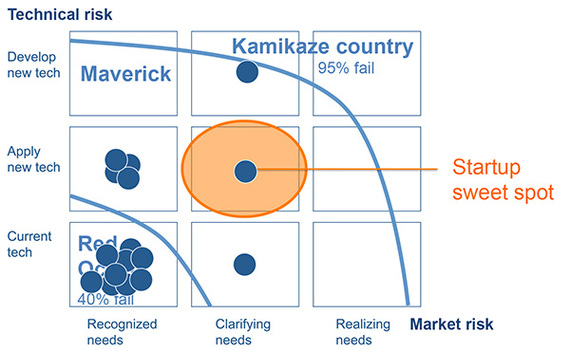Co-written by Tyrone Howard and Steven Bussard
Stanford studies on design quality and entrepreneurial risk show that the sweet spot for startups is right in the middle of Market and Technology Risk.
This entails:
1. Taking new technology and applying it
2. Meeting needs that have already been identified by the market
Observing these criteria reduces the risk of developing unproven new technology and selling into a market that does not exist. Studies of pitches from Techsparks Pasadena show that most startup pitches take on far too little Market and Technology Risk.
If one has an idea for a new business that falls in the Sweet Spot, at some point, investors will need to be convinced that they should invest.
This may be much easier said than done since entrepreneurs can be pigheaded and the longer they have worked their plan, the harder it is for them to abandon it. In Behavioral Economics, this is described as the "Endowment Effect" and "Sunk Cost Effect." So, how can entrepreneurs learn quickly before their journey becomes too costly? The answer is to pitch and pitch again.
Tyrone Howard served as an Organizer/Facilitator and Strategic Partnerships & Public Relations liaison for Innovate Pasadena and has observed thousands of pitches - some great, some awful. He noticed that his wife could watch "American Idol" and judge whether a song was good or bad within the first 15 seconds. Was the crowd cheering, did the judges jump up and were there tears in her eyes?
A winning investor pitch has similar requirements:
- Know yourself and your audience
- Grab the audience's attention at the start
- Finish strong
Let's explore these requirements in greater detail.
Know Yourself and your Audience
Without knowing their audience, entrepreneurs are flying blind.
Entrepreneurs usually pitch to one of the following audiences:
- Scrappy fellow entrepreneurs at a Startup Weekend
- Young investors in a sophisticated angels group
- Retired doctors and lawyers with money
- Venture Capital firms
- Large companies looking to fill a technical weak spot
Each of these audiences has different knowledge, assets, and goals and an entrepreneur must learn how to successfully pitch to each of them.
Grab the Attention of Your Audience
Plan and rehearse your first 15 seconds. Be yourself. If you can't tell a joke, please don't try.
One of the best ways to start a pitch is by telling the story of how you first realized there was a problem to solve.
Or you could get the audience involved by asking a question to draw them in.
Paint a clear picture of the problem you are solving. Describe vividly the negative impact it has on people, business, or society. Then describe the positive benefits your solution will provide.
Remember that the benefits must be significant since no one starts a company just to shave fifteen percent off the cost of the current solutions. The goal is to be disruptive!
Finish Strong
Remind your audience how your company can solve the problem and greatly benefit those in need of your solution. Close with a simple sentence, such as, "I'm George Putney, our company is Purple Lion and we are "Building your Place in Space."
When your audience wakes up the next morning they need to be thinking about your presentation and talking to their investor friends about what they just heard.
How Can I Create a Great Pitch?
Be clear about what to do and why to do it. Think back to the moment when you first came up with that great idea for a new business. Clearly explain how you have a solution that people will pay for and share your plan for building and selling that solution.
Share your pitch with different types of audiences over and over again. If pitching to an audience of friends or colleagues, ask them afterwards for their feedback. Was anything confusing? Were some sections too long? Did they have unanswered questions? Would they invest in your venture?
The winners on American Idol don't just go on stage and wing it. They only finally perform live after many hours of rehearsal, practice and making numerous small changes to their presentation. So, continue to practice and improve and you too can give a killer pitch.
Special thanks to Tyrone Howard and Steven Bussard for researching and co-writing this article
